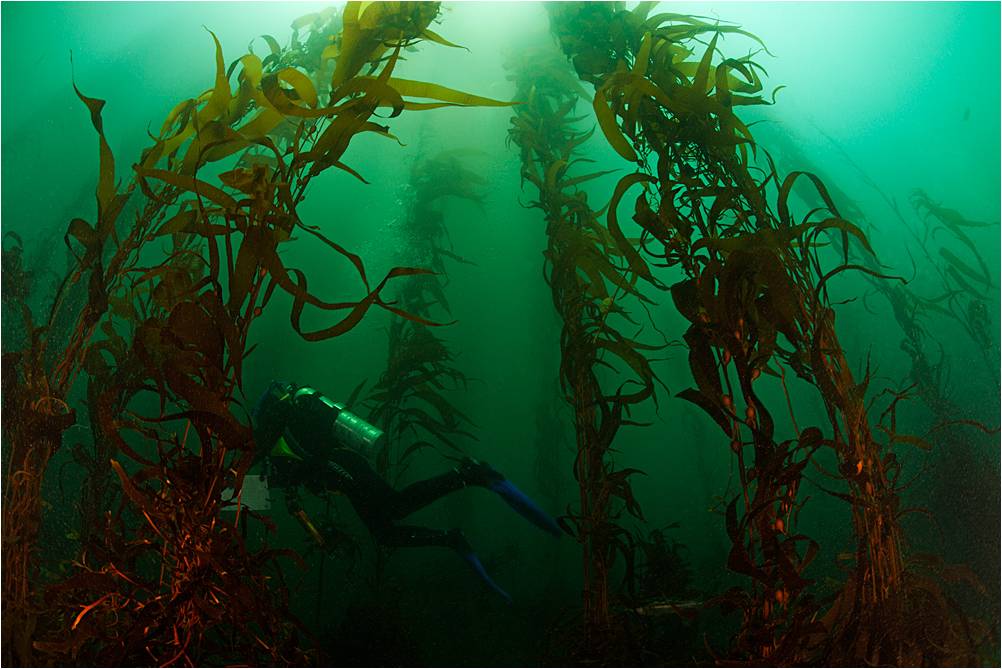Assessing the role of fish in kelp forests and rocky reefs.

There is a widespread perception that the healthier an ecosystem is, the more species it will have (1). This way of understanding nature focuses on defining which species are present without explaining their role in the ecosystem. An approach focusing on species’ functions seeks to identify the components of diversity that influence ecosystem performance (2). When we have two communities with the same number of species we could believe that their response to any changes, natural or induced, will be the same. For example, one of these communities could have multiple species that share functional traits like biological (e.g. type of food), morphological (e.g. body shape), and ecological characteristics (e.g. habitat preference). These species may play similar roles in the ecosystem, so they make up a functional group. Therefore, variations in the presence or density of a single species may be compensated by other species of the same functional group. Meanwhile, the second community could have a single species that is responsible for multiple functional groups. In this case, a decline in this species’ population would result in the loss of multiple ecosystem roles. From this perspective, the loss of a single species can have varying effects on ecosystem function, and it becomes clear that maintaining all ecosystem functions is more important than temporary or permanent changes at the species level.

Kelp forests (Macrocystis pyrifera) and rocky reefs are characteristic ecosystems of the Pacific coast of Baja California. Kelp forests are one of the most productive ecosystems, housing a great diversity of fish, while rocky reefs sustain some of the most important fisheries in the region (3). However, the abundance of macroalgae and three dimensional structures that giant kelp generate means greater opportunity for the diversification of ecosystem functions. Meanwhile in the rocky reefs the macroalgae and food network supported by this ecosystem are more limited. At the present, natural and human stressors, as well as selective species exploitation, are increasing, making it important to understand the responses of marine ecosystems at a function level, rather than at species level, and to identify functions that can be vulnerable in future scenarios.
We conducted visual surveys through scuba diving (5) in four kelp forests (Las Rosas, Rincón de Ballenas, La Bufadora and Campo Kennedy) and four rocky reefs (Punta Morro, Rincón de Ballenas, La Bufadora and Zeppelin) during the spring of 2014. We chose functional traits that incorporate four main fish characteristics: maximum size, type of food, habitat preference, and body shape. We evaluated kelp density and substrate rugosity to analyze its association with the diversity of functional groups. Also, we calculated the fish density to understand their role within the same ecosystem and between the two types of ecosystems (4).
Major Findings:
While the number of species and functional groups was similar in both ecosystems, species and functional groups were different between sites and ecosystems. The influence of a functional group in the ecosystem depended on the number of species that made up that group and their densities. Kelp forests were found to be dynamic environments with higher densities of fish and more differences in the number of functional groups between sites. The greatest diversity of species occurred in Rincón de Ballenas (23 species), while Las Rosas had the highest functional diversity (13 groups). Rocky reef ecosystems, on the other hand, were more homogeneous, with no significant differences between the number of functional groups and the different types of groups present.
In the rocky reefs, six functional groups were formed by one species, while in kelp forests only three groups had a single species, suggesting that kelp forests may be less vulnerable to possible disturbances. Habitat characteristics, like the density of macroalgae, are important to establish more functional groups and help explain differences within the same ecosystem.
Authors:
María Paula Sgarlatta*, Arturo Ramírez Valdez**, Luis Eduardo Calderón Aguilera*
Contact Information:
DOI:
10.13022/M3GP44
Affiliations:
* División de Oceanología, Centro de Investigación Científica y de Educación Superior de Ensenada. Carretera Ensenada, Tijuana 3918, 22860, Ensenada, Baja California, México. ** Marine Biology Research Division, Scripps Institution of Oceanography, University of California San Diego, La Jolla, CA 92093-0202, USA
Acknowledgements:
This work was part of the MSc thesis of the senior author who was supported by CONACYT grant (CVU: 476805). The project was partially supported by CICESE (Ref 622143).
How to cite this story:
María Paula Sgarlatta, Arturo Ramírez Valdez, Luis Eduardo Calderón Aguilera (2016): Assessing the role of fish in kelp forests and rocky reefs. DataMares. InteractiveResource. http://doi.org/10.13022/M3GP44
References
McGrady-Steed, J., Harris P.M., Morin, P.J. (1997). Biodiversity regulates ecosystem predictability. Nature 390, 162-165.
Tilman, D. (2001). Functional diversity. Encyclopedia of Biodiversity, 3(1), 109–120.
Allen L.G., D.J. Pondella, M.H. Horn. (2006). The ecology of marine fishes. California and adjacent waters, Berkeley: University of California Press. pp. 3–25.
Sgarlatta, M.P. (2015) Análisis de la diversidad taxonómica y funcional de la comunidad de peces de arrecifes rocosos y de bosques de macroalgas de Baja California, México. [MSc Thesis] 2015. CICESE.
Ramírez-Valdez A., G. Montaño Moctezuma, G. Torres Moye, J.C. Villaseñor Derbez, O. Aburto-Oropeza (2014): Counting fish in the Kelp forests of Baja California. DataMares. InteractiveResource. http://dx.doi.org/10.13022/M3BC7X

